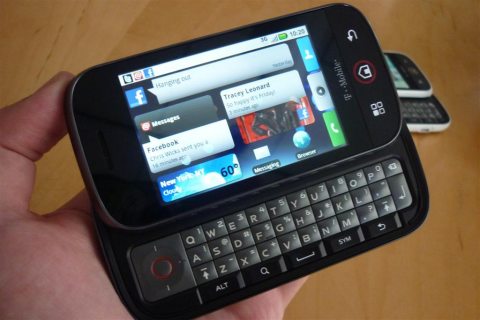Hands-on with the Motorola Cliq smartphone [review]

I recently got the chance to get hands-on with Motorola's major smartphone debut, the touchscreen-QWERTY slider smartphone called CLIQ.
My take: Motorola's CLIQ is a game-changing device for T-Mobile.
[Image Gallery: Motorola CLIQ with Motoblur]
To me, the CLIQ is a power user's dream phone: it combines touch and keyboard for choice of input; it offers Microsoft Exchange support as well as built-in Google services integration; it's got robust support for images, audio and video; it offers Wi-Fi, Bluetooth and 3G GSM connectivity.
[Read the full specifications list here]
Adding to that solid Android feature set is Motoblur, a Motorola interface that's built on top of the Google platform. Much more than a skin, Motoblur preserves most of the Android experience but allows Motorola to compete more directly with the Palm Pre and Apple iPhone on certain fronts. Like webOS on the Palm Pre, Motoblur bases contact and conversation between people on an identity, rather than the protocol (IM, e-mail, text, etc.). Similarly, Motoblur uses a feed-based widget architecture to surface content on the home page, rather than require you to dive into an app.
The experience is liberating. No longer needing to duck in and out of applications to stay connected, you find yourself watching activity as it comes in. The home screen can be customized to display various social media (Twitter, Facebook, Yahoo! Messenger, AIM, Google Talk, etc.), but it can also be programmed to display stocks, sports scores, news feeds (such as ZDNet!) and more.
Succinctly, Motoblur puts the untapped power of the Android platform closer to your fingertips.
The hardware felt solid and well-built in my hands, and the sliding hinge felt robust. Motorola's designers paid attention to detail, and finished the exposed backside of the touchscreen display with a stainless steel finish and glowing Motorola badge, only visible when the keyboard is extended.
Motorola also decided to rethink Android's key set on the outside of the phone itself. Instead of using separate buttons for pick up, hang up, home, menu, back and search (such as on the myTouch 3G), Motorola centered the home button, encircling it with a ring to distinguish it from the other buttons, and flanked it with the menu and back buttons (the entire panel is flush).
The pick up and hang up buttons have been moved to virtual buttons that appear in the bottom corners of the display. While I enjoyed the simplicity of the button set on the outside, I thought the pick up/hang up buttons ought to be a bit bigger on-screen.
User-centric features have also made it to the CLIQ, including an accelerometer (for GPS navigation, games and input), a proximity sensor, an ambient light sensor, dual-mic noise cancellation and a standard 3.5mm audio jack that will support any headphones you may have.
I asked Christopher Conrad Edwards, a senior manager in Motorola's consumer experience design department, to run through the main features of the CLIQ for ZDNet readers.
Here's a video:
The video is immensely out of focus, but you can see (fuzzily) how the UI is manipulated and hear why it's designed that way.
Motorola told me that it's not positioning it for any specific audience, but Edwards spent considerable time showing me the various ways you can communicate with someone through a single method. While that's a no-brainer for social media types out there, it's also an extremely powerful tool for business users.
(The CLIQ also offers QuickOffice with Document Viewing.)
Add all that to a battery rated at 6 hours of continuous usage and a 5.6-ounce weight that felt lighter in my hand than the brick-like G1 (they actually weigh the same).
The CLIQ isn't a revolutionary device the way that Apple's iPhone was, but that's part of its appeal. A clever refinement of the Android platform, the Motoblur-powered CLIQ manages to pair the robust feature set of a BlackBerry with the smooth visual interface of an iPhone.
Together, that adds up to a compelling smartphone that could, if not poach users from other carriers, please T-Mobile customers immensely.
